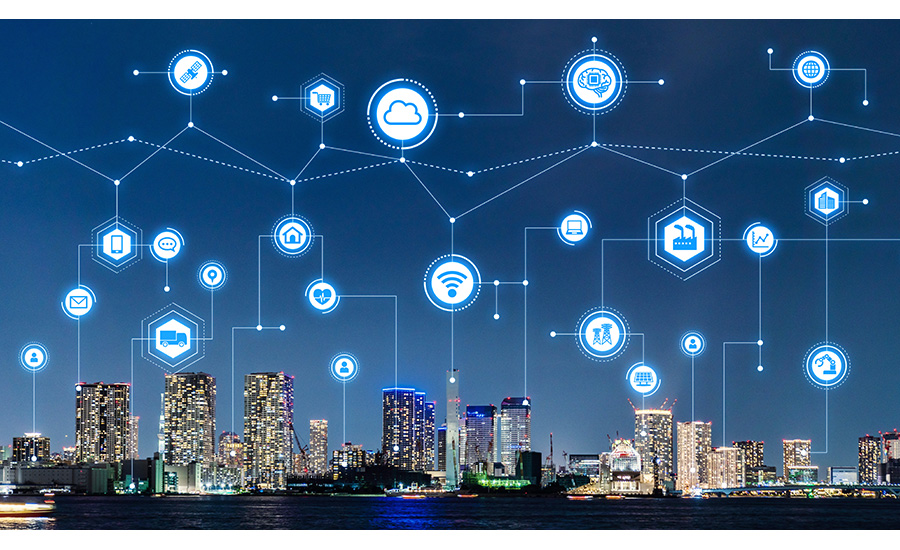
Increasing confidence in a return to normal across all business sectors in 2021 led to big growth for integrators providing access control products and services, such as Ojo Technology Inc. in Fremont, Calif., says CEO and Founder Angie Wong. // IMAGE COURTESY OJO TECHNOLOGIES
Access Control Is Opening Doors to More Than Security
Once relegated to simple locks and card reader panels, access control is assuming a starring role in overall business operations and security integrators are capitalizing on this trend.
Access control is having a red carpet moment. While access control has been part of an integrated platform for many years — particularly in the enterprise world — it assumed a widespread starring role during the first wave of COVID-19 as businesses looked for ways to monitor employee health and promote touchless entry. 
Two years later, as companies continue tweaking the workplace and welcoming employees back into the office, access control is taking its place as a fully integrated element of a business’s security and operational requirements.
“A modern, fully digitized access control and visitor management system enables facility and security managers to track visitors and employees, analyze occupancy rates and traffic patterns, and create reports that can help facility managers create a safer and healthier environment for occupants,” says Sheeladitya Karmakar, global offering leader at Honeywell Commercial Security, Atlanta. “Leveraging frictionless access controls and visitor management to support the well-being of occupants has been a key point of growth to the industry over the last two years.”
Access control is in an interesting and exciting time, says James K. Lantrip, senior vice president, operations, Allied Universal Technology Services, an integrator headquartered in Santa Ana, Calif. While the market still has many mainstay products that are “hardware-centric,” new open market products are changing the dynamic of the field. “We’re making less hardware sales,” he says. “Making it more open architecture will benefit consumers and business as a whole. It’s doing what the video industry did over the past 10 years.”
COVID-19 amplified what access control systems could already do, says Samuel Joseph, co-founder and CEO of Hakimo, Menlo Park, Calif. With COVID-19 came contact tracing, and businesses needing to keep strict logs of who entered a building. Modern access control systems can provide that, and run reports for their COVID task force to determine next steps in pandemic mitigation. “COVID in some sense made enterprises aware of the power of the access control system,” he says.
“We saw higher confidence in ‘reopening’ and going back to normal in 2021 across sectors, and particularly in the private enterprise sector,” says Angie Wong, CEO and founder of Ojo Technology Inc., Fremont, Calif., featured on this month’s cover.
Integrators Rate Their Confidence in the Access Control Market
SDM asked security systems integrators how they would rate the current state of the access control market, including on-premises and cloud/web-based/hosted.
Fifty-two percent of the respondents to the SDM 2022 Forecast (conducted in November 2021) rated their confidence in the access control market as very good or excellent, with only 14 percent believing it was fair/poor. This represents a 5 percentage point bump from last year’s perception. // SOURCE: SDM 2021 AND 2022 INDUSTRY FORECAST STUDIES
During the pandemic, businesses implemented remote or hybrid work practices to reduce onsite staffing, making access control an even more vital tool to secure facilities, says Bruce Stewart, business development manager, Axis Door Solutions, Axis Communications, Chelmsford, Mass. The downside was that many companies also reduced office space or sold off real estate holdings, reducing the need for systems. “That said, many industries require facilities and onsite work, and in retrospect many have also realized the value of in-person work, so some level of balance between remote and onsite work will be restored,” he adds.
The shift to remote work also means employees are using more networks to access facilities, Karmakar says. Couple this with the large staff turnover during the “Great Resignation,” and it translates to many contractors and former employees still having corporate access cards. “With these two factors in mind, it is a priority for facility managers to bolster the security — and remote capabilities — of their building’s access controls.”
The pandemic also pointed out the limitations of outdated access control systems, says Despina Stamatelos, senior commercial manager for access control at Genetec, Montreal. “Many organizations knew their (systems) were old, but just lived with it as long as it worked. But having to work remotely and manage access remotely from home with aged systems posed a lot of security risks,” she says.
“COVID-19 accelerated customer demand for certain access control system capabilities such as remote connectivity and management, touchless access, and more robust occupancy management solutions,” adds Ewa Pigna, chief technology officer at LenelS2, Pittsford, N.Y.
Customer demand for more security, coupled with increased government and manufacturing standards, means more businesses are expanding their access control systems and using them to manage their operations, says John Becker, global vice president of sales, AMAG, Hawthorne, Calif. “In the 1990s, security directors wanted access control for one thing: to lock doors and let people in,” he says. “Now, it’s an operational issue. Whether it’s airline employees, or hospital workers that need to get into a supply room, facilities managers say it’s important to operate their facilities. Access control products have become a mainstay of business, not just for security.”
Beyond Protecting Doors & Buildings
STANLEY Security’s 2022 Industry Trends Report finds that 46 percent of business leaders have already implemented traditional physical security solutions such as access control, and more than three in four (78 percent) say their organization has rapidly adopted new technology due to the pandemic.
In addition, 66 percent of business decision makers are considering redesigning their physical spaces to better accommodate hybrid work environments, according to a recent Microsoft Work Trend Index.
Majority Expect Revenue From Access Control to Increase
SDM asked, “How do you expect revenue from access control systems, including on-premises and cloud/web-based/hosted systems, to change in the next year?”
Of those surveyed for SDM’s Industry Forecast, 46 percent expect revenue from access control systems (on-premise and cloud-based) to increase in 2022, 50 percent expect it to remain the same, and 4 percent expect revenue to decrease. // SOURCE: SDM 2022 INDUSTRY FORECAST STUDY
To deliver on these demands, manufacturers are ramping up integrating access control into video surveillance, smart buildings, artificial intelligence, and other platforms, making it an invaluable part of not only security, but also business operations.
For instance, early in the 2020 lockdown, Brivo introduced four new features specific to enforcing locking and making it safe for employees to enter the workplace, with one being a way for people with mobile credentials to answer a set of health questions before they could get in, says Steve Van Till, founder and CEO of the Bethesda, Md.-based manufacturer.
Before COVID-19, most customers viewed access control as a tool to keep bad people out, so the value proposition was always around security, says Eric Trabold, CEO of Nexkey, San Mateo, Calif. “In the last 18 months, however, access control has become a tool to manage how you can get good people back into the workplace, because it’s more than just something that protects doors and a building.”
Nexkey got the timing right by releasing its Nexkey dashboard in Q2 2020, Trabold says. The dashboard provides intelligent insights on a building’s spaces from data captured from access control, including occupancy rates, flow of people, and which building entrances are used most. This not only proved invaluable during the pandemic, but also offers organizations ways to improve processes, he says.
Popular uses for access control today include not only health monitoring, but full integration with business elements like human resources to provide appropriate access and simplify onboarding new employees; smart building systems to control temperature and lighting; and determining whether to expand or scale back office space based on usage, all tracked by access control, Trabold says.
“Integration on all levels is very important moving forward,” says Spencer Britenstine, director of sales, South U.S., Aiphone, Redmond, Wash. “Customers expect relevant products that fit the current needs of society. Ease of use and functionality are paramount, all while incorporating the latest technology.”
Lucas Ingala, founder and CEO, Watchmen Security Services, Kansas City, Mo., says, “Access control is becoming the fourth utility for a building.” Having technology such as AI, biometrics, video integration, cloud, touchless access, and more on the same platform in an easy-to-use way for the end user will have a big impact on the market, he adds.
Although there has always been an auditability component to access control, “Prior to the pandemic, this primarily meant reviewing who went where,” says Jay Slaughterbeck, CEO of Strategic Security Solutions, a Security-Net member, Raleigh, N.C. “In light of COVID-19, this has facilitated other things such as contact tracing and quarantine time enforcement. It has also been used to evaluate real estate, to determine if a facility has too much or not enough space. These access control solutions have been available for quite some time, but now the data have become increasingly useful to clients need to make significant business decisions.”




